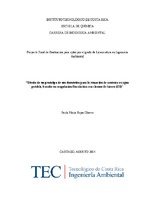Diseño de un prototipo de uso doméstico para la remoción de arsénico en agua potable, basado en coagulación/floculación con cloruro de hierro (III)
Abstract
In the North and in the North Pacific areas of Costa Rica, high concentrations of arsenic in
drinking water have been found exceeding the guideline of 10 μg/L established by the
Health Department of the country and also by the World Health Organization. Point of use
systems based on coagulation/flocculation and filtration for arsenic removal was a solution
for this problem. A prototype was developed using iron (III) chloride as a coagulant. Two
flocculants were tested a synthetic one (cationic polymer KF-930-S) and natural one
(“mozote” Triumfetta semitriloba). The optimum conditions were determined by jar tests
with challenge water from the National Science Foundation and an initial arsenic
concentration of 200 μg/L, these conditions were pH 6, iron (III) chloride dose of 12 mg/L
and 14 mg/L for the cationic polymer and mozote, respectively, and cationic polymer dose
of 1 mg/L and mozote of 250 mg/L. The time for the slow mix and settling were also
determined: 1 and 20 min, respectively. A conventional treatment and a direct filtration
were compared with jar tests with filters coupled; the first treatment and “mozote” as
flocculant proved to be more convenient. The built prototype consists of two tanks, the first
where the coagulation/flocculation/sedimentation happens and the second containing the
sand filter with an effective size of 0,5 mm. The prototype provided a good performance
using “mozote” as flocculant, reaching up to 99% removal, with initial concentrations of
200 μg/L, which results in a value less than 10 μg/L of arsenic in water. The efficiency of
the protoype was also tested with water from the North Pacific of the area of Bagaces with
an arsenic concentration of 10 μg/L, after the treatment the result was 3 μg/L of arsenic.
This system is a very efficient, low cost and easy operation alternative for arsenic removal.
Description
Proyecto de Graduación (Licenciatura en Ingeniería Ambiental) Instituto Tecnológico de Costa Rica, Escuela de Química, 2014


